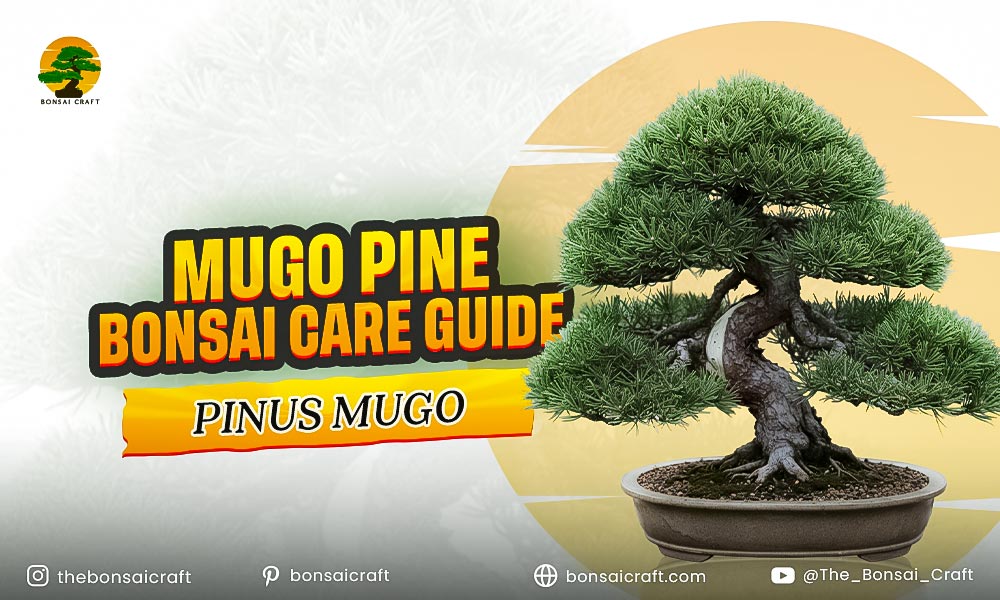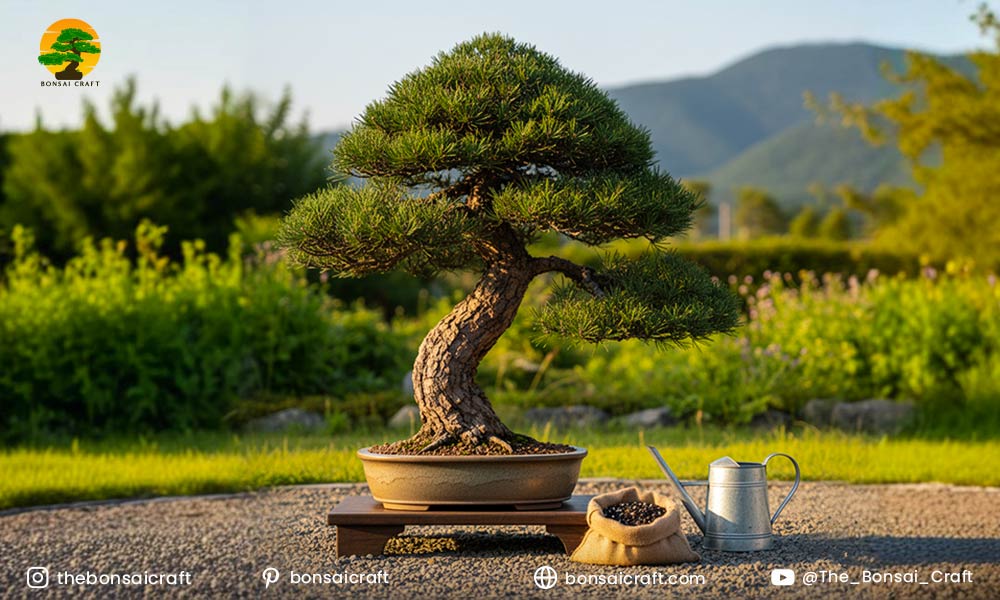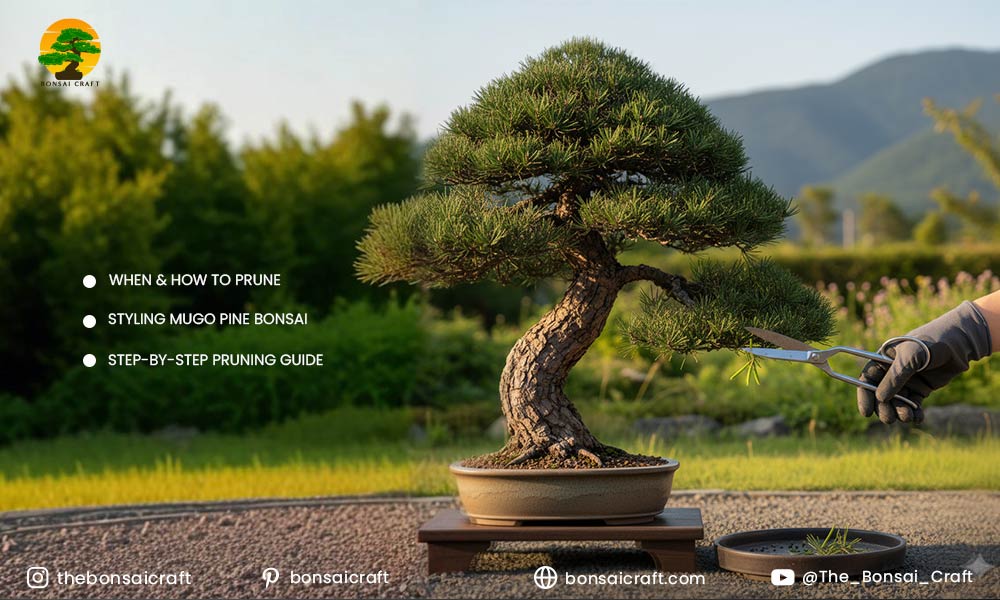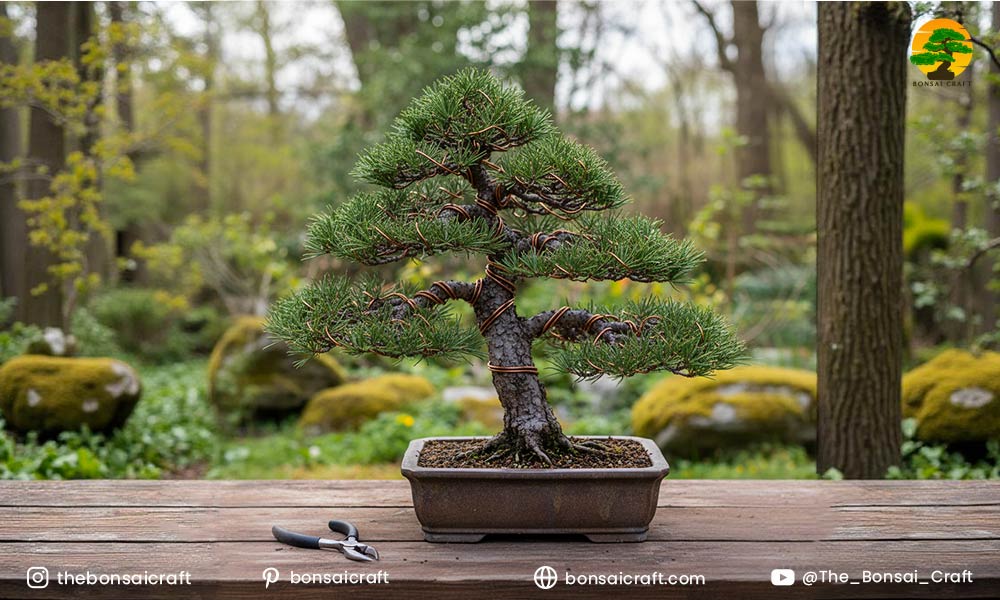
The mugo pine bonsai (Pinus mugo bonsai) is a classic choice among bonsai enthusiasts because of its rugged character, adaptability, and resilience. Known for its dense needle clusters and naturally compact growth, the bonsai mugo pine captures the essence of alpine landscapes in miniature form.
Over the years, I’ve worked with different pine species, and the mugo pine bonsai stands out as both challenging and rewarding. This guide combines practical experience, expert horticultural advice, and proven bonsai techniques to help you master mugo pine bonsai care from watering and soil to pruning, wiring, and repotting.
Why Grow a Pinus Mugo Bonsai?
The Pinus mugo, or mountain pine, thrives in harsh mountain environments, which makes it naturally hardy. As a bonsai, it offers several benefits:
- Compact growth: Perfect for bonsai styling with tight foliage pads.
- Durability: Tolerates cold winters and thrives in outdoor conditions.
- Styling flexibility: Suitable for upright, slanting, and cascade bonsai designs.
- Longevity: A well-cared-for bonsai mugo pine can live for decades, often becoming a family heirloom.
This tree is ideal for growers who enjoy patience-demanding species that evolve beautifully over time.

Mugo Pine Bonsai Care Essentials
Light & Placement
The mugo pine bonsai requires full sun exposure for at least 6–8 hours daily. It is best grown outdoors year-round to ensure proper dormancy in winter. Avoid keeping it as an indoor bonsai except for short display periods.
Watering
Like most pines, Pinus mugo bonsai dislikes soggy roots. Water deeply, then allow the soil to partially dry before watering again. In hot summer months, check daily; in winter, water less frequently but never allow the soil to dry completely.
Soil & Fertilization
- Use a free-draining bonsai soil mix: akadama, pumice, and lava rock (2:1:1).
- Fertilize in spring and autumn with a balanced slow-release fertilizer (NPK 10:10:10).
- In midsummer, switch to a low-nitrogen fertilizer to encourage woody growth over excessive needles.
How to Bonsai a Mugo Pine
To bonsai a mugo pine, start with a healthy Pinus mugo tree, prune it to define the structure, and train with wire. Use a well-draining soil mix, repot every 3–5 years, and manage growth through seasonal pruning and candle pinching.
Detailed process:
- Choose material: Nursery stock or yamadori (wild-collected trees).
- Establish trunk line: Identify a natural flow before cutting major branches.
- Prune for structure: Remove crossing or unnecessary branches.
- Wire branches: Bend gently to create pads and shape.
- Refine growth: Through candle pinching and needle reduction each year.
When to Prune Mugo Pine Bonsai
The best time to prune a mugo pine bonsai is late spring to early summer, once new shoots (candles) have hardened. Avoid heavy pruning in autumn or winter, as the tree needs energy to prepare for dormancy.
Timing is crucial for mugo pine bonsai pruning. Pinching or pruning too early weakens the tree, while pruning too late can lead to uncontrolled growth. Always leave some needles on each branch for photosynthesis.

How to Prune Mugo Pine Bonsai
To prune a bonsai mugo pine, pinch or cut back candles in spring, thin dense foliage to allow light inside, and remove unwanted branches to enhance structure. Never strip all needles from a branch, as it can weaken or kill it.
Step-by-Step Pruning Guide
- Candle Pinching (Spring): Reduce candle length by one-third to one-half.
- Needle Thinning (Summer): Remove older needles to balance energy.
- Structural Pruning (Winter): Remove deadwood or weak branches.
Proper pruning helps maintain compactness and encourages back budding.
Styling Mugo Pine Bonsai
The bonsai mugo pine adapts beautifully to different styles:
- Informal Upright (Moyogi): Reflects natural windswept curves.
- Slanting (Shakan): Highlights movement and dynamism.
- Semi-Cascade (Han-kengai): Mimics alpine cliff growth.
- Group Plantings: Several mugo pines can form a miniature mountain forest.
Wiring should be done in late autumn or early spring, when branches are most flexible. Use copper wire for mature wood and aluminum for younger branches.
When to Repot Mugo Pine Bonsai
Repot a mugo pine bonsai in early spring, just before bud swelling begins. Young trees may require repotting every 2–3 years, while mature specimens only every 4–5 years.
Repotting Guidelines
- Use a well-draining bonsai soil mix.
- Remove no more than one-third of the root system.
- Do not combine heavy pruning and repotting in the same year.
- Provide shade and wind protection for 2–3 weeks post-repotting.

Wiring and Shaping Pinus Mugo Bonsai
Wiring is essential for creating elegant designs with mugo pine bonsai.
- Apply wire in spring or autumn.
- Wrap at 45° angles for stability.
- Avoid wiring during peak summer growth or deep winter dormancy.
- Monitor regularly—remove before it cuts into the bark.
Wiring combined with careful pruning leads to well-defined foliage pads and a strong, balanced structure.
Seasonal Care for Bonsai Mugo Pine
Spring
- Repot (if needed).
- Begin fertilization.
- Pinch candles to control growth.
Summer
- Increase watering.
- Thin needles and prune strong shoots.
- Protect from extreme heat.
Autumn
- Fertilize with low-nitrogen formula.
- Prepare tree for winter dormancy.
Winter
- Protect roots from severe frost (below -10°C).
- Provide outdoor dormancy (avoid heated indoor storage).
Common Problems in Mugo Pine Bonsai Care
- Overwatering: Leads to root rot. Always use free-draining soil.
- Pests: Watch for aphids, scale, and spider mites. Neem oil or systemic treatments help.
- Wiring Scars: Check wires monthly, as pines thicken quickly.
- Weak Back Budding: Caused by poor sunlight or excessive pruning.
Expert Tips for Healthy Mugo Pine Bonsai
- Never prune and repot in the same year, as it stresses the tree.
- Always leave some needles on each branch for survival.
- Observe natural mountain pines for styling inspiration.
- Patience is key: true refinement of Pinus mugo bonsai takes decades.
Conclusion
The mugo pine bonsai (Pinus mugo) is a hardy and versatile bonsai tree that rewards patient growers with timeless beauty. With proper knowledge of when to prune mugo pine bonsai, when to repot mugo pine bonsai, and the best styling techniques, you can shape a miniature masterpiece that thrives for decades.
From personal experience, the key to success lies in respecting seasonal timing, balancing growth through pruning, and never rushing the natural pace of the tree. A well-styled bonsai mugo pine is more than a plant—it’s a living expression of resilience and artistry.
FAQs on Mugo Pine Bonsai Care
How do you care for a mugo pine bonsai?
A mugo pine bonsai needs full sun, well-draining soil, and regular watering. Prune candles in late spring, repot every 3–5 years, and fertilize in spring and autumn for balanced growth.
When should you prune mugo pine bonsai?
Prune a Pinus mugo bonsai in late spring to early summer, when new candles have hardened. This maintains health and encourages compact growth.
How often should you repot mugo pine bonsai?
Repot young bonsai mugo pine every 2–3 years, and mature trees every 4–5 years. Always repot in early spring before buds swell.
What styles work best for mugo pine bonsai?
The bonsai mugo pine suits informal upright, slanting, semi-cascade, and forest plantings. Wiring and candle pinching refine the structure.
What soil is best for Pinus mugo bonsai?
A mix of akadama, pumice, and lava rock works best for mugo pine bonsai. This ensures proper drainage while retaining enough moisture for roots.
